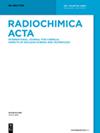克服最终氟-18 放射性标记物中乙腈含量过高的障碍
IF 1.7
3区 化学
Q4 CHEMISTRY, INORGANIC & NUCLEAR
引用次数: 0
摘要
摘要 乙腈被广泛用作合成各种氟-18 正电子发射断层扫描(PET)放射示踪剂的溶剂。乙腈被列为二类残留溶剂,由于其固有的毒性,药物产品中的乙腈残留量必须加以限制。在放射性示踪剂的放射性合成过程中,按照《药品生产质量管理规范》(GMP)进行操作时,目的是控制即用产品中所有溶剂的浓度。所有产品都必须符合预定的规格。在极少数情况下,可能会超出这些限制。为避免剔除整批产品,最好采用一种直接的基于时间的技术,以便安全地使用大 部分产品。这种技术应基于确定一个特定的时间和数量,在完成质量控制分析后,放射性示踪剂可用于患者。在此,我们报告了一个基于现有数学公式的非常简单的 Excel 表程序,该程序可计算出患者可安全使用放射性示踪剂产品的确切时间和用量。本文章由计算机程序翻译,如有差异,请以英文原文为准。
Overcoming the obstacle of excess acetonitrile content in the final fluorine-18 radiotracers
Abstract Acetonitrile is widely used as a solvent in synthesizing various fluorine-18 positron emission tomography (PET) radiotracers. Acetonitrile is classified as a Class II residual solvent, and due to its inherent toxic properties, the quantity of residual acetonitrile in drug products has to be limited. When working under Good Manufacturing Practices (GMP) during the radiosynthesis of a radiotracer, the aim is to control all solvent concentrations contained in the ready-to-use product. All products must meet predetermined specifications. Rarely, these limits may be exceeded. To avoid eliminating the entire batch, applying a straightforward time-based technique would be desirable to allow the majority of the product to be safely used. This technique should be based on determining a specific time and volume for which the radiotracer can be utilized in the patients after completing quality control analysis. Here, we report a very simple Excel sheet program based on existing mathematical equations that calculates the exact time and volume at which the radiotracer product can be safely administered to a patient.
求助全文
通过发布文献求助,成功后即可免费获取论文全文。
去求助
来源期刊

Radiochimica Acta
化学-核科学技术
CiteScore
2.90
自引率
16.70%
发文量
78
审稿时长
6 months
期刊介绍:
Radiochimica Acta publishes manuscripts encompassing chemical aspects of nuclear science and technology.
 求助内容:
求助内容: 应助结果提醒方式:
应助结果提醒方式:


